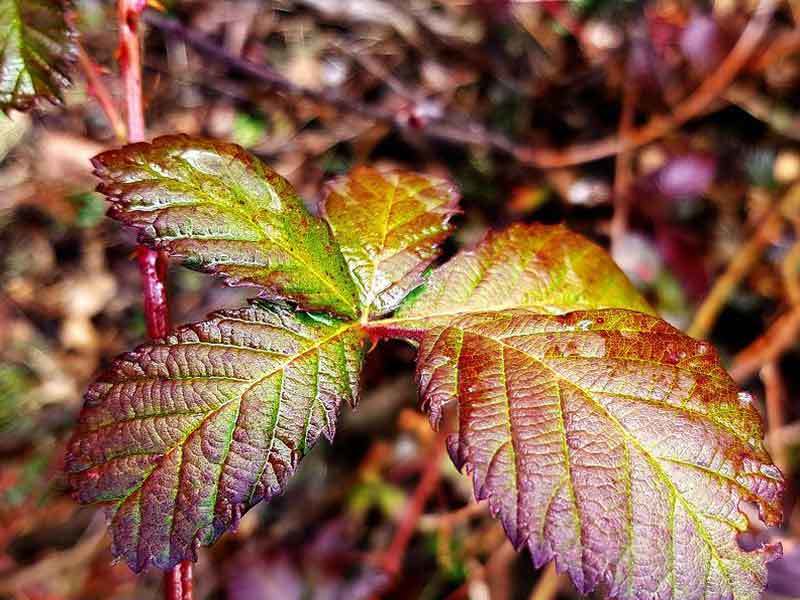Blackberry Leaves Turning Red: Causes and Treatment
Introduction
Why Are My Blackberry Leaves Turning Red? We will cover the reasons and how to fix this color transformation.
Environmental Factors
Temperature
Extreme temperatures can disrupt the normal function of plant cells. This disturbance can lead to increased production of anthocyanins. The leaves will turn red as a protective and adaptive measure.
Sharp drops in temperature can shock plants and lead to blackberry bush leaves turning red. If the drop is sudden, the plant may not have had time to acclimate.
Shielding your plants from the direct midday sun during extremely hot periods. You can cover them partially or use shade clothes. In cold climates, cover or move them indoors during frosty nights. This can keep the leaves from turning red.
Sunlight
Insufficient or excessive light can both lead to blackberry plant leaves turning red. Inadequate light means the plant is unable to produce enough energy for its needs. Conversely, excessive light can damage chlorophyll and lead to a red or purple hue.
High levels of sunlight can accelerate ethanol production within the leaves. Excess ethanol can lead to increased leaf senescence. The red leaves are not a sign of fall but an early cry for help from the plant.
Blackberries generally thrive in full sun. Shade cloth can modulate the impact of light on your blackberry bushes. Avoid planting in low-lying areas. Provide a windbreak to protect against winter winds.
Water Stress
Dehydration and over-hydration are both enemies of the blackberry plant. Drought can cause the plant's stomata to close. This leads to water stress and leaf loss.
Conversely, waterlogged soil can rob the roots of oxygen. This leads to reduced uptake of water and nutrients. The leaves will wilt, yellow, and eventually turn red.
Add mulch around the base of the plant can help retain moisture and regulate soil temperature. Ensure proper soil drainage can prevent waterlogged roots.

Pests and Diseases
Common Pests and Diseases
Blackberry leaves turning red may also be a response to the presence of pests or diseases. Spider mites, cane borers aphids, and various fungal diseases are common pests and diseases. They can cause leaves to lose their vigor and turn red.
Spider mites are arachnids that feed on the sap. These tiny pests can cause stippling, yellowing, and a bronze or red coloration of the leaves.
Aphids feed by sucking the sap from the plant and excreting a sticky substance called honeydew. This can lead to sooty mold growth and, eventually, the reddening and dropping of leaves.
Fungal diseases can also turn blackberry leaves red. For example, rust, cane and spur blight, and septoria leaf spot. These diseases manifest as red spots or lesions on the leaves. They affect the plant leaves.
Pest Management and Disease Prevention
Monitor your plants regularly to manage these pests and diseases. Beneficial insects and natural predators can help keep the population of pests in check. For example, ladybugs.
Some practices can help prevent fungal diseases before they start. For example, improving air circulation, proper spacing, and regular pruning. Organic remedies can keep your blackberry plants healthy and green. For example, neem oil and horticultural soap.
Nutrient Deficiencies
Essential Nutrients
Nutrient deficiencies are one of the primary reasons behind blackberry leaves turning red. Blackberries require macronutrients and micronutrients to thrive. For example, nitrogen, phosphorus, iron, magnesium, and manganese. A shortage can cause distinct symptoms in the leaves.
Recognizing Symptoms
Chlorosis, or the yellowing of plant leaves, is a common symptom of nutrient deficiencies. In blackberries, when the issue persists or becomes more severe, the leaves can turn red.
Blackberry bush leaves turning red often cry for help. A general reddening may indicate a deficiency in nitrogen, responsible for leaf maturation. While a purpling along leaf veins can suggest a lack of phosphorus. It is instrumental in energy transfer.
Soil Testing and Fertilization
Soil testing to address nutrient deficiencies. Detailed soil analysis can pinpoint which nutrients are lacking. This allows for the application of targeted fertilizers.
If nitrogen deficiency is the culprit, a high-nitrogen fertilizer could restore the balance. For example, ammonium sulfate. Similarly, incorporating phosphorus-rich amendments can combat phosphorus deficiencies. For example, bone meal.
Cultural Practices
Proper Pruning, Watering, and Mulching
Regular pruning can maintain the plant's shape. This also encourages new growth and air circulation. Adequate watering and a layer of mulch can help regulate the soil's moisture. This prevents water stress and root rot.
Soil pH and Drainage
Blackberries prefer slightly acidic soil with a pH between 5.5 and 6.5. You should keep the soil pH in this range. Ensure good drainage through the addition of organic matter. These can improve nutrient uptake and overall plant health.
Weed Control and Spacing
Weeds can deplete the soil of nutrients and water. Invasive plants can also inhibit air circulation, becoming catalysts for disease. Proper spacing allows for ample light and space to grow. For example, 3-4 feet between plants. This minimizes competitive stress.
Conclusion
You should understand the reason for blackberry leaves turning red. Take steps to provide the right growing conditions. Your bushes will produce a bountiful crop year after year.

